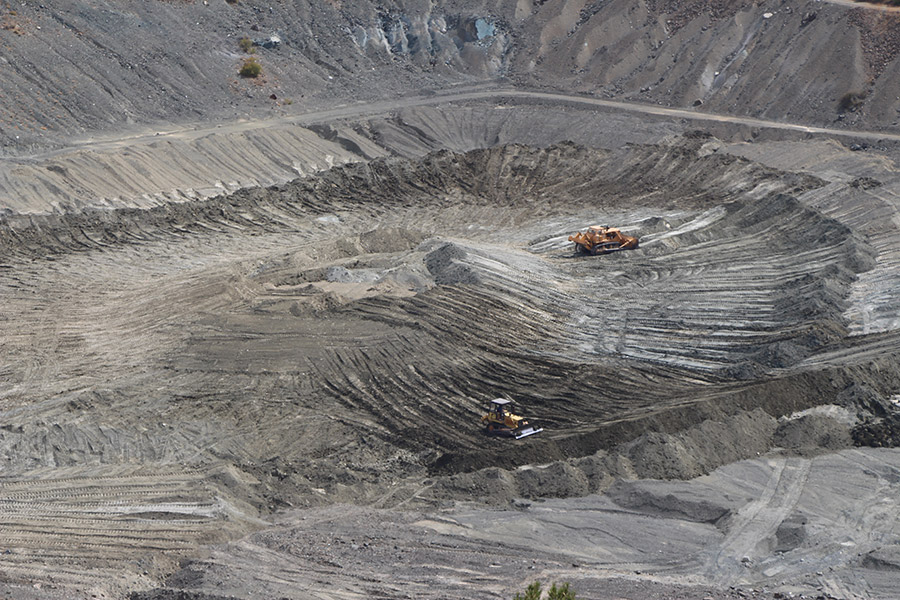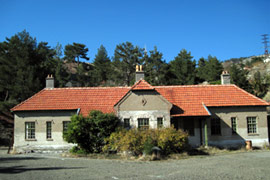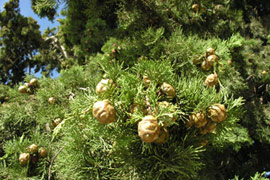From Asbestos to Biodiversity
In the heart of the Troodos National Forest Park, an abandoned asbestos mine poses a threat to people, fauna and wildlife alike. With support from the Grants, biodiversity protection and good management practices are being emphasised in the rehabilitation of the mining area. 19.11.2014
The last piece of asbestos was dug out of the Amiantos mine in 1988. However, restoration of the area is still ongoing. Underway since 1995, the rehabilitation process is a lengthy and complex task expected to be completed in 2030. The support from Iceland, Liechtenstein and Norway is part of a wider effort to preserve local biodiversity by enhancing capacity and know-how in restoration procedures, health and safety standards, and conservation techniques. The Department of Forests of the Cypriot Ministry of Agriculture, Natural Resources and Environment manages the project. Need for restorationThe rehabilitation of the mining is essential for the surrounding area. In addition to being one of Cyprus’ most popular tourist locations, the Troodos National Forest Park is a Natura 2000 site, belonging to an EU wide network of natural conservation areas. “[The park] is mostly natural and a very valuable habitat for many native plants and animals. Its conversation status is good, although it receives many visitors with all the subsequent consequences. The Amiantos mine is a blight on this valuable area,” explains project manager Takis Tsintides. “While it was operational, the mine contributed significantly to the prosperity of surrounding area, in particular as a major employer. But gradually it became clear that it also had a negative impact on human health. Many people died from diseases related to asbestos, like asbestosis and mesothelioma,” continues Tsintides. Likewise, the surrounding area is a water catchment area which flows towards one of the island’s largest dams providing water for domestic consumption.  The restoration of the abandoned mine is both a large and complex task. Photo: Department of Forests, Ministry of Agriculture of Cyprus
Few plants have grown around the mine over the last decades as the soil has mostly been removed, leaving a shallow and coarse ground with a high pH value and limited nutrients. In the recent years, the risk of landslides has also become a concern, threatening lives and properties below the mine. Expert knowledgeThe aim of the project is to create a stable and self-sufficient forest ecosystem by evaluating and improving the current restoration techniques. “We had to convince the staff that it is not enough to just plant trees. We need to deal with other aspects and needs as well, such as doing it effectively, using the correct plant species, paying attention to the needs of biodiversity and also taking landscaping and visitor needs into consideration,” says Tsintides. Now, new methods are being implemented with the help of a hydro-seeding and mine restoration experts who have evaluated the previous restoration work and provided training seminars for the staff. The experts have also complied guidelines on hydro-seeding, mine and quarries restoration, and on the controlling invasive species, which will be used throughout the whole restoration process, as well as in other similar schemes in Cyprus. Visible resultsThe change in the area is already detectable. Out of the 14 hectares of mine waste planned to be restored under the project, ten are already completed. An artificial lake is also being created at the core of the mine pond which is expected to meet the area’s irrigation and wildlife needs.  A restored part of the Amiantos Mine. Photo: Department of Forest, Ministry of Agriculture of Cyprus
Even though the project is still not completed, it has already garnered positive attention. “The local communities were informed about the project and its progress at two information events organised in June in 2013 and 2014 and they all expressed their satisfaction about the project,” says Tsintides, adding that environmental groups have also voiced their support of replicating the lessons learned in other mines and quarries. Essential fundingThe project receives around €1.1 million from Iceland, Liechtenstein, and Norway, making it the largest project supported through the Cypriot ‘Biodiversity and Ecosystem Services’ programme. “The support of the EEA Grants has proved very valuable as Cyprus has been facing an unexpected economic crisis since 2013,” notes Tsintides. “This has enabled restoration work to continue at a good pace, which otherwise would have been postponed as a result of drastic cuts in the department’s annual budget.” The project began in early 2013 and will run through to 2015. See more photos from the project in the EEA and Norway Grants media library Read more about the Cypriot ‘Biodiversity and Ecosystem Services’ programme Read more about the EEA Grants to Cyprus
Key FactsCountry: Cyprus Project title: Biodiversity Conservation in Restoration and Management of the Amiantos Asbestos Mine in Troodos National Forest Park Project number: CY02-0001 Priority sector: Environmental Protection and Management Grant: € 1138050 Status: In Progress Project promoter: Department of Forests - Ministry of Agriculture, Natural Resources and Environment Type of Institution: Government ministry Project website: http://www.moa.gov.cy/fd Project duration: 35 months Project cost: € 1,350,000 Grant from: EEA Grants The Amiantos asbestos mine closed down in 1988 is located within a Natura 2000 site in the Troodos National Forest Park. Rehabilitation of the area started in 1996 and is estimated to take up to 40 years. Reforesting the site and revitalising the area is needed to make this part of the National Park less hazardous for the local population to live in (now close to an open pitch Asbestos mine) and more attractive for tourists to visit. The project will contribute to halting the loss of biodiversity at the site by improving mine restoration and management practices. Enhanced capacity and know-how in restoration procedures, health and safety standards and conservation techniques will ensure more effective management of the Natura 2000 site. Improving the surrounding landscape will also make the site more attractive for visitors. Target Groups: entire society of Cyprus, inhabitants of the local communities, the Department of Forests and professionals in mine restoration and scientists.
|
Latest News
Prev
Next
05-05-2017 Final information event of the project «Biodiversity Conservation in Restoration and Management of the Asbestos Mine» On Saturday, 29 April 2017, the final information event of the project “Biodiversity Conservation in Restoration and Management of the... Read more20-09-2016 CONSTRUCTION OF THE ARTIFICIAL LAKE IN AMIANTOS MINE- PLACEMENT OF GEOTEXTILE Within the framework of the project "Biodiversity Conservation during the restoration and management of the Asbestos Mine EEAGrants" the Forest... Read more30-11-2015 Hydro seeding for the year 2015 at the Asbestos mine Between 23-26 of November took place at Amiandos mine the hydro seeding for the year 2015. Hydroseeding is a specialized... Read more16-10-2015 Restoration works in the Amiantos Asbestos Mine during summer and autumn 2015 Implementation of the project “Biodiversity Conservation in Restoration and Management of the Amiantos Asbestos Mine” continued at an intensive rate... Read more07-10-2015 Construction of the artificial lake at Amiandos Mine For theimplementation of the project “Biodiversity Conservation in Restoration and Management of theAmiantosAsbestos Mine”,the Forest department is currently addressing the... Read more01-07-2015 Checking of artificial nests placed to assist the nesting of wild birdsThe artificial nests that were placed to improve the habitat of wildlife were checked recently. More specifically, in 2014, 80 artificial... Read more27-02-2015 Film Presentatio "Asbestos: Past, Present and Future"On Wednesday, February 18, the film "Asbestos: Past, Present and Future" was shown to a packed auditorium at the University of Nicosia. The film has been produced within the project... Read more09-01-2015 Hydro seeding for the year 2014 at the Asbestos mine Between 16-18 of December took place at Amiandos mine the hydro seeding for the year 2014. Hydroseeding is a specialized... Read more09-01-2015 Asphalt pavement and retaining wall construction Asphalt pavement of about 430 meters was conducted at the Amiandos Mine, on a road next to the lake. Initially... Read more02-12-2014 Two – day Seminar on “Biodiversity Conservation in Restoration of Mines and Quarries in Cyprus” The seminar was held on 27-28.11.2014 at the Troodos Botanical Garden "A.G. Leventis’ and addressed the issue of “Biodiversity Conservation... Read more |


